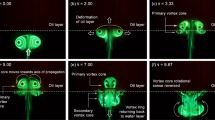Abstract
This paper describes experiments in which small volumesV of heavy fluid were released in the uppermost of two uniform layers of fluid and the degree of penetration into the lower layer determined.
When the injected fluid had no initial velocity and was initially a distanceZ′ above the interface between the two layers, less than about ten percent of it continued into the lower layer whenA = ( Q2 − Q1 )Z′ 8/( Qi − Q1 )V was greater than 29; more than about 90% continued into the lower layer if A was less than 1.5. Pi and 02 are the densities of the upper and lower layers of fluid, respectively, andQ1 is the density of the injected fluid.
When the heavy fluid was injected with an initial velocity a vortex ring formed. The vortex ring was found to remain intact during its travel in the lower layer if Λ was less than 0.2 (K2/F)3 whereK is the initial circulation of the injected fluid andF=g(( Q −Q1 )/Qi)V is the buoyancy parameter associated with this fluid while in the upper layer. For values of Λ < 0.3 (K2/F)3, although these rings broke in the lower layer, it appeared that more than 90 % of the ring fluid continued in the lower layer.
Similar content being viewed by others
References
Batchelor, G. K.: 1954,Quart. J. Roy. Meteorol Soc. 80, 339.
Richards, J. M.: 1961,J. Fluid Mech. 11, 369.
Richards, J. M.: 1963,Int. J. Air Water Pollut. 7, 17.
Saunders, P. M.: 1962,Tellus 14, 177.
Scorer, R. S.: 1957,J. Fluid Mech. 2, 583.
Turner, J. S.: 1957,Proc. Roy Soc. London (A) 239, 61.
Turner, J. S.: 1960,J. Mech. Eng. Sci. 2, 97.
Turner, J. S.: 1964,J. Fluid Mech. 19,481.
Woodward, B.: 1959,Quart. J. Roy Meteorol Soc. 85,144.
Author information
Authors and Affiliations
Rights and permissions
About this article
Cite this article
Sullivan, P.J. The penetration of a density interface by heavy vortex rings. Water Air Soil Pollut 1, 322–336 (1972). https://doi.org/10.1007/BF00294008
Received:
Issue Date:
DOI: https://doi.org/10.1007/BF00294008




